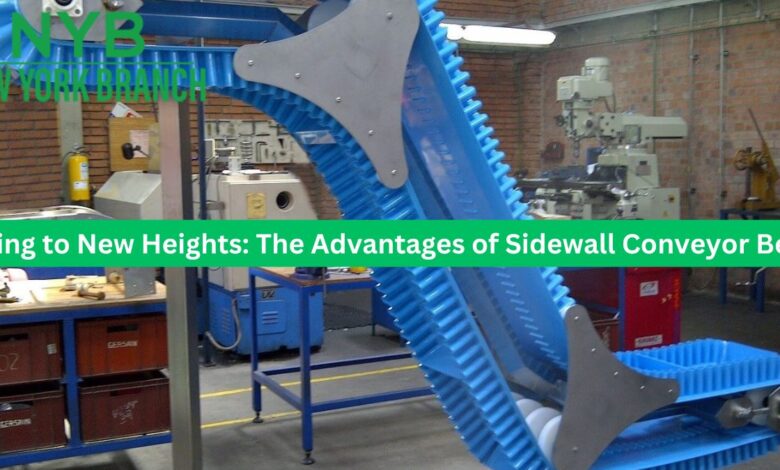Rising to New Heights: The Advantages of Sidewall Conveyor Belts

In the dynamic landscape of material handling and industrial processes, conveyor belts play a pivotal role in ensuring smooth and efficient transportation of goods. Among the various types of conveyor belts available, sidewall conveyor belts have emerged as a robust solution, offering several advantages that contribute to their widespread adoption across diverse industries.
1. Versatility in Handling Challenging Materials
One of the standout features of sidewall conveyor belts is their ability to handle a wide range of materials, including those that are traditionally difficult to convey. The design of these belts incorporates vertical sidewalls that act as barriers, preventing materials from slipping or falling off during transportation. This characteristic makes sidewall conveyor belts particularly effective in conveying bulk materials with irregular shapes, high angles of repose, or those prone to spillage.
Industries dealing with bulk materials such as mining, agriculture, and construction benefit significantly from the versatility of sidewall conveyor belts. These belts can effectively navigate through challenging terrains, ensuring the seamless transfer of materials from one point to another without the risk of spillage or loss.
2. Increased Conveying Capacity
Sidewall conveyor belts are designed to maximize conveying capacity while minimizing the footprint of the conveyor system. The vertical sidewalls on these belts create a containment area that allows for a higher volume of material to be transported at steeper angles. This increased conveying capacity is particularly advantageous in situations where space constraints or terrain limitations necessitate a more compact and efficient conveyor solution.
Industries with high-volume material handling requirements, such as mining and manufacturing, can benefit significantly from the enhanced conveying capacity of sidewall conveyor belts. The ability to transport larger quantities of materials in a confined space translates to improved operational efficiency and reduced overall costs.
3. Superior Sidewall Conveyor Belts
One of the defining characteristics of sidewall conveyor belts is their superior ability to handle steep inclines. Traditional flat conveyor belts may struggle with conveying materials at steep angles, leading to the need for complex conveyor systems or additional equipment. eliminate this challenge by providing a stable and secure transport mechanism even at high incline angles.
Industries involved in quarrying, steep terrain applications, or those requiring vertical conveying find sidewall conveyor belts to be a game-changer. These belts enable the efficient movement of materials up inclines that would be impractical or even impossible with other types of conveyor systems, opening up new possibilities for system design and operational flexibility.
4. Reduced Spillage and Environmental Impact
Sidewall conveyor belts significantly contribute to environmental sustainability by minimizing material spillage during transportation. The vertical sidewalls act as a containment barrier, preventing materials from escaping and reducing the risk of environmental pollution. This feature is particularly crucial in industries dealing with hazardous or environmentally sensitive materials.
By minimizing spillage, sidewall conveyor belts help companies adhere to environmental regulations and reduce the need for costly cleanup efforts. Additionally, the containment of materials contributes to improved workplace safety by mitigating the risk of accidents related to spilled materials on conveyor systems.
5. Customizable Design for Varied Applications
The adaptability of sidewall conveyor belts extends to their customizable design, allowing for tailored solutions to meet specific application requirements. Manufacturers offer a variety of sidewall heights, belt widths, and cleat configurations to accommodate the unique needs of different industries and material types.
Whether it’s handling bulk materials in agriculture, transporting minerals in mining operations, or conveying waste and recycling materials, sidewall conveyor belts can be designed to match the specific demands of the application. This versatility makes sidewall conveyor belts a preferred choice for industries seeking efficient and customized material handling solutions.
6. Cost-Effective and Low Maintenance
In addition to their performance advantages, sidewall conveyor belts offer cost-effective solutions for material handling. The increased conveying capacity and efficiency of these belts contribute to overall cost savings by optimizing operational processes. The ability to handle steep inclines also eliminates the need for additional equipment, reducing both capital and maintenance expenditures.
Furthermore, sidewall conveyor belts are known for their durability and low maintenance requirements. The robust construction and high-quality materials used in manufacturing contribute to extended belt life and reduced downtime. This combination of cost-effectiveness and low maintenance makes sidewall conveyor belts a financially prudent choice for industries looking to enhance their material handling capabilities.
Conclusion
In the ever-evolving landscape of industrial processes, sidewall conveyor belts stand out as a reliable and efficient solution for material handling challenges. Their versatility, increased conveying capacity, superior incline capability and environmental benefits make them a preferred choice across diverse industries.
As companies strive to optimize their material handling operations, the advantages offered by sidewall conveyor belts position them as a key player in the quest for efficiency, cost-effectiveness, and environmental responsibility. From mining and agriculture to manufacturing and waste management, sidewall conveyor belts are rising to new heights, reshaping the way materials are transported and contributing to the evolution of modern industrial processes.


